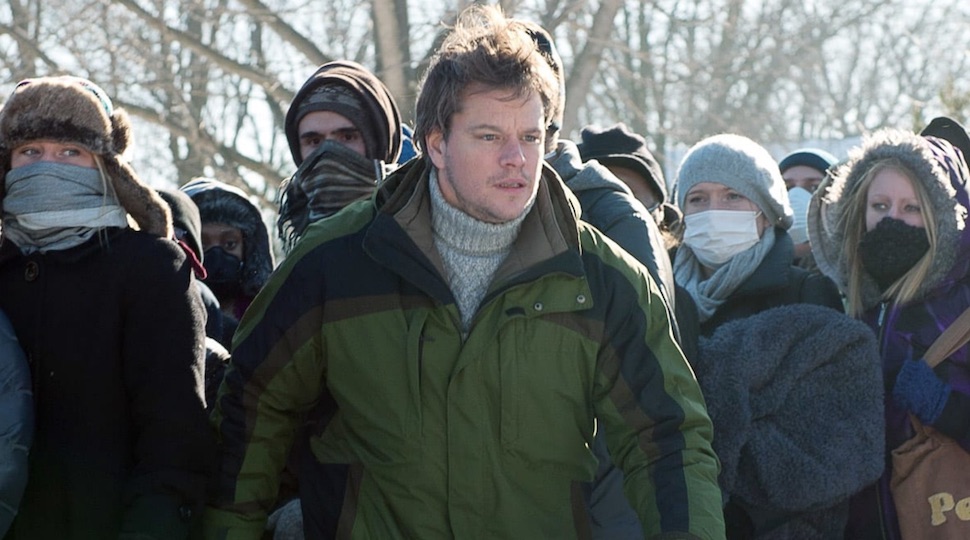Over the last few weeks there’s been a new trend in my social media feed of people watching Steven Soderbergh’s 2011 film, Contagion. Look, people have to cope with whatever anxiety they are feeling right now in any way that might possibly help, but for the life of me I can’t figure out how that helps. It’s almost as if every member of the media watched Contagion, then either wrote or tweeted about it – which resulted in Contagion now having a “renewed popularity” section added to its Wikipedia page.
This Contagion resurgence all feels a little bit like that scene in Almost Famous on the airplane when there’s that first bit of turbulence and Russell Hammond starts singing “Peggy Sue.” As a way to make light of a situation, hoping the morbid joke will make the what’s possibly coming next all go away. And then, as we know, the plane starts to crash before finally veering out of the storm. Hopefully, we van veer out of this current storm, too. (Speaking of that scene, I once randomly tweeted Jimmy Fallon’s line, “I once hit a man in Dearborn, Michigan. A hit and run. I hit him and just kept on going. I don’t know if he’s alive or dead… but I’m sorry. Not a day goes by I don’t see his face.” Soon after I got a call from my mom asking if I needed a lawyer.)
Anyway, that was a long way of saying, no matter how much you want me to, Contagion is absolutely the last movie I’m going to watch right now. (And, again, do what you want, but I’d also advice anyone reading this that watching Contagion right now is a terrible idea.)
Though in preparation for this piece about how there’s no way I’ll watch Contagion, I looked back at a 2011 interview I did with Steven Soderbergh about Contagion. It is, well, a bit ominous. It’s no longer online, so I’ll just cut and paste this relative passage here:
I’m assuming you tried to get this as accurate as possible?
Yeah, all of the science in it is airtight. Ian Lipkin, who is at Columbia, designed the virus, essentially. Both in terms of how it would have come into existence and then literally the design of it – that scene where Jennifer Ehle and Laurence are looking at it on a screen and she’s describing what it does – Ian designed that. So it’s for real. It’s a very realistic, plausible fictional virus.
So you basically asked him, “Give me your worst-case scenario?”
You know, we talked through a couple of different scenarios and this one seemed the most plausible. When you’re dealing with wet markets during certain periods of the year and you don’t have refrigeration, this is a hotbed of this kind of stuff.
I’m almost scared to ask, but how plausible?
Oh, very! That’s how a couple of these things have started. That’s how the sort of species jump takes place. I don’t know if you’ve ever been to a wet market in Asia, but it’s pretty intense.
What was the most surprising or disturbing thing that you learned during your research?
There were two things that were unsettling. One is that everyone that you spoke to said, “we’re due for a big one.” And some of the stories, from the people who go out and parachute into these situations, how politics have prevented them from doing their work are really depressing. Where they literally show up somewhere where there’s been an outbreak of a treatable disease and they’re there with the supplies ready to go in. And because a volatile political situation existed, they weren’t allowed in to keep people from dying. They don’t have jurisdiction anywhere. You have to ask them to come; they have to be invited.
You see some of the ugly side of the human spirit in this film. Do you think it would be that bad, rioting at the drug stores?
It’s like anything. You’ll see the best of people and you’ll see the worst of people.
Though, strangely enough, in my new lifestyle of social distancing and not watching Contagion, I found myself drawn to another movie about the spread of a pandemic, And the Band Played On. I hadn’t watched it since it’s early days on HBO, and my biggest memory was its harrowing look at the early days of the AIDS crises as people died and no one knew why. Rewatching today, what more stands out about the film itself is how the U.S. government completely botched the response, as scientists argued and sued over who should get the credit for discovering what would eventually become known as HIV. (Alan Alda is terrific in a heal turn as Robert Gallo, who finagled his way into getting partial credit for discovering the virus.) It’s a startling look into the bureaucracy of a pandemic. Where hospitals didn’t want to screen donated blood because it would cost too much. Where a sitting president decided to just ignore what was happening until many, many people had died. In its own way, it’s much more frightening than Contagion because what happened is true, and we are seeing some of the same mistakes, deception, and government lethargy play out in right in front of us today. (Also, I forgot how great the cast is in this film. Steve Martin even shows up. Though, I forgot where we went through a phase in which Phil Collins became an actor and this came out right smack in the middle of that era.)
So, no, I will not be watching Contagion. I cannot think of a movie I’d rather watch less at this particular moment. (Except for, maybe, Dirty Grandpa.) Maybe I’m the crazy one, but I also don’t start singing “Peggy Sue” at the first hint of turbulence.
You can contact Mike Ryan directly on Twitter.







